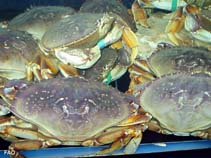Metacarcinus magister (Dana, 1852)
Dungeness crab| Native range | All suitable habitat | Point map | Year 2050 |

|
| This map was computer-generated and has not yet been reviewed. |
| Metacarcinus magister AquaMaps Data sources: GBIF OBIS |
Классификация / Names народные названия | синонимы | CoL | ITIS | WoRMS
Malacostraca | Decapoda | Cancridae
Environment: milieu / climate zone / пределы глубины / distribution range экология
; солоноватоводный; пределы глубины 0 - 360 m (ссылка 865). Temperate; 3°C - 19°C (ссылка 104779), preferred 9°C (ссылка 107945); 61°N - 23°N, 179°W - 110°W
Distribution страны | регионы FAO | Ecosystems | места находок | интродукции
Eastern Pacific: Aleutian Islands, Alaska to Magdalena Bay, Mexico. Subtropical to boreal.
Length at first maturity / Size / Weight / Возраст
половая зрелость: Lm ?, range 10 - ? cm Max length : 22.5 cm CW самец/пол неопределен; (ссылка 865); 16 cm CW (female); наибольший возраст (опубликованны данные): 10 годы (ссылка 104779)
Life cycle and mating behavior половая зрелость | размножение | нерест | Eggs | Fecundity | Larvae
Основная ссылка
ссылки | координатор | соавторы
Shirley, S.M., T.C. Shirley and S.D. Rice 1987 Latitudinal variation in the Dungeness crab, Cancer magister: zoeal morphology explained by incubation temperature. Mar. Biol. 95(3):371-376. (ссылка 8391)
Статус Красного Списка МСОП
(ссылка 130435: Version 2025-1)
Статус СИТЕС (ссылка 108899)
CMS (ссылка 116361)
Угроза для людей
Использование человеком
рыболовство: коммерческий
FAO - рыболовство: landings, Видовой профиль | FishSource | Sea Around Us
инструменты
дополнительная информация
ресурсы в Интернет
BHL | BOLD Systems | CISTI | DiscoverLife | FAO(рыболовство: Видовой профиль; publication : search) | Fishipedia | GenBank (Геном, Нуклеотид) | GloBI | Gomexsi | Google Books | Google Scholar | Google | PubMed | Tree of Life | Wikipedia (Вперёд, поиск) | Zoological Record



